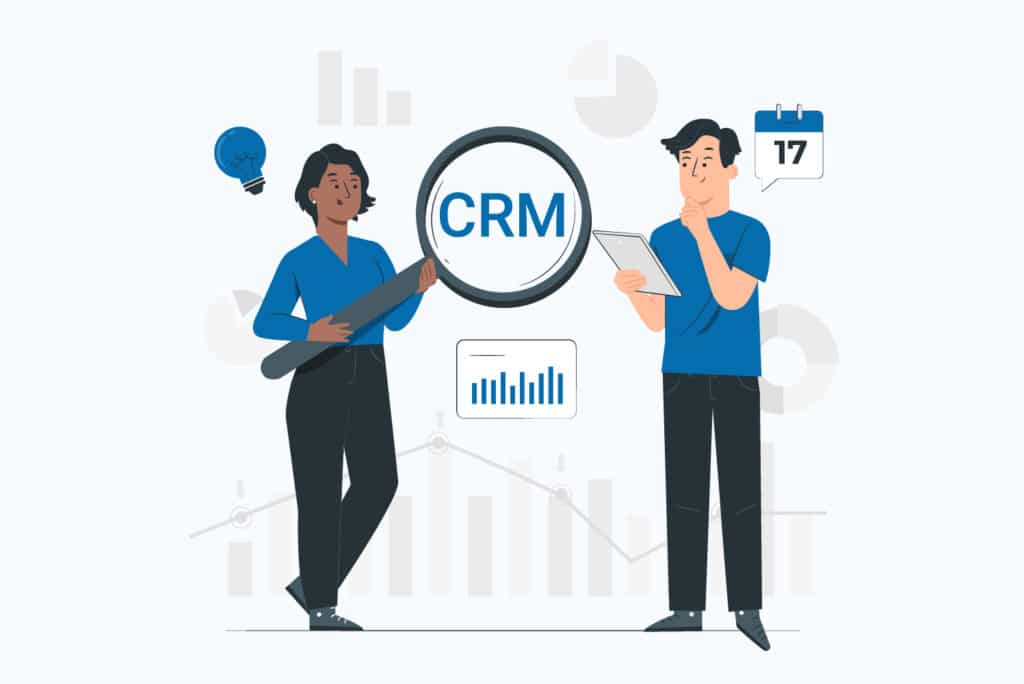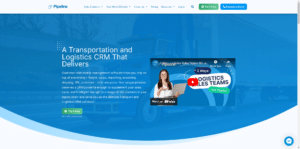The majority of customers expect personalization.
Are you delivering?
According to Twilio’s State of Personalization report, 85 percent of the businesses surveyed believe they’re offering personalized experiences to their customers. Of course, they believe that; why wouldn’t they?
How do customers feel about that?
Only 60 percent of customers agree that this is the case. That’s an important detail when you realize 45 percent of customers will take their business elsewhere if personalization is less than adequate; 80 percent of customers who view themselves as repeat buyers say they’ll only do business with brands that personalize the experience.
Why CRM is best for personalization
Customer relationship management (CRM) tools are an essential and foundational part of personalization. Used consistently, CRM empowers your team, enabling you to provide customers with the one-on-one attention they need at scale.
- Track all customer interactions: With a centralized CRM tool in place, your team can harvest all of the data that comes from your customer interactions and the sentiment that goes with it — phone, chat, email, social, text, etc. Have a group of customers who are unhappy with your customer service? Need to know which customer anniversaries are coming up? CRM is a scalable way to help your team manage this data. As an aside, your CRM tool should integrate with the communication channels you’re already using.
- Customize customer follow-up: You’ve collected customer data; your team is better prepared for your next customer interaction. Use this data to help your team craft thoughtful responses, letters, and scripts. Follow up with customers using the right tone and voice. Continue to collect data with each customer interaction, doing your best to provide customers with the care, guidance, and protection they need.
- Improve customer experiences: Using the data you’ve harvested, you can provide customers with the kind of one-on-one engagement that boosts loyalty. Let’s say your customers are unhappy with the service they received on their previous call; if your sales and support team follows up with specific details about their complaints, their perceptions of your business improve dramatically.
- Analyze reporting to align expectations: Are you noticing that customers reach out to discuss the same problems? Create an email or ad campaign that addresses it proactively. Are customers bringing up similar objections, frustrations, or pain points? Use the data in your reports to determine where you should focus your organization’s attention first.
Can you see what’s happening?
Many ‘smart’ personalization tools rely on aggregate data that’s generic and vague. With CRM, you’re able to use the data you receive from your customers on a day-to-day basis.
This is what makes CRM so powerful in your hands.
What the wrong CRM will cost you
Choosing the wrong CRM comes with significant downsides. Scott Edinger, a management consultant, had this to say about CRM systems and the reasons why they fail.
"In my work with clients, when I ask executives if the CRM system is helping their business to grow, the failure rate is closer to 90%. The primary reason they miss the mark in helping companies increase revenue is that CRM systems are too often used for inspection — to report on progress, improve the accuracy of forecasts, provide visibility, predict project delivery dates, and provide a range of other business intelligence — rather than creating improvement in the sales process. Front-line sales professionals and managers rarely find the majority of these capabilities useful in winning more business for the company."
Scott Edinger
There are a variety of consequences that come with this.
First, there’s decreased user adoption; for example, front-line sales and marketing teams aren’t using the CRM system because oftentimes, it wasn’t selected with them in mind. It was chosen to provide management or executives with the information they wanted.
Second, organizational silos and turf wars are amplified.
Customer service chooses to rely on a different CRM system than the one management selected for sales and marketing. Neither system communicates with the other, and the company, as a whole, never really gains a complete view of their customers.
That’s unfortunate.
Third, customer goodwill erodes over time; customer data isn’t centralized and shared throughout the organization, so customers aren’t heard. Since the organization relies on multiple CRM systems, one department has a small piece of the customer’s data. Another department has a different set of data on customers.
Neither is interested in sharing.
The wrong CRM goes unused. It’s an investment that fails to produce any return, which is exactly what it’s supposed to be doing, helping your business grow. This is why it’s so important to select the right CRM for your organization.
How to choose the right CRM for your organization
It’s easier to select the best CRM system when it’s oriented around your business. This may sound difficult, but it’s actually a straightforward task if you focus on a few key details to start.
- Treat CRM as a tool to increase revenue. This is the primary role of your CRM system. As the name suggests, its primary focus is giving you the tools you need to build stronger relationships with your customers. This produces more revenue for customers.
- Start with a single department or area of your business. Sales, marketing, and customer service are the easiest and most intuitive places to start with your CRM program since they’re the most obvious revenue-generating areas of your business. This phased rollout is essential for reasons I’ll touch on later.
- Create a list of customer and organization needs. Create a list of data that your employees need (e.g., a record of customer objections, complaints, comments, motivations to buy, etc.) to make the CRM system profitable. Next, create a list of customer needs (e.g., detailed knowledge of recent events, activity, complaints, calls, etc.); you’re looking for areas of overlap. These areas of overlap will provide you with a list of core features (i.e., your customers expect every support rep to know everything about their account).
- Identify possible product options. These candidates are vendors with a specific CRM tool. They should be able to provide you with both a free trial (or demo) and onboarding once you’re a customer. Your winning candidate should be a team you can pick up the phone and call, chat with, or message. You shouldn’t have to pay for additional help or extra services to get the most out of their product; you’re already paying them for access.
Here’s where most companies go wrong.
Commonly, a single person (or small group of people) will choose the CRM for an entire department. This is a disaster in the making because it increases transitional pain and it decreases adoption rates. When software is forced on your employees, it’s yet another thing they’re expected to learn.
There’s a better way.
If you want your employees to buy in — to consistently use the CRM system you’re about to invest in, you’ll need to give them a chance to weigh in. Patrick Lencioni, a legendary management consultant, talks about achieving employee buy-in.
See that?
Earning buy-in doesn’t require that everyone agree about which CRM system is best. It simply requires that you allow everyone to weigh in (positive or negative) on the decision being made.
This is key.
Remember the phased rollout I mentioned earlier? This is why it’s a great idea to start small with a specific department (i.e.,) or a small team. A phased rollout gives you the ability to provide employees in a particular team the chance to weigh in.
Which, as we’ve seen, earns your team’s buy-in.
Why is buy-in important?
Achieving buy-in means it’s easier to persuade employees to use the CRM system you ultimately decide on. They’re more likely to use it because they were given a chance to weigh in.
This isn’t enough, though.
Your CRM system of choice needs to be intuitive and functional to earn their continued support. The easier it is for your team to do their work, the more likely they will use it.
What to look for in your CRM tool
Your CRM tool should include the right mix of product features. This is where it’s important to balance preferences. If you’re like most people, you want the best CRM for your team, a fully-featured product that does everything your team needs and more.
That’s a bad idea.
A better idea is to keep things as simple as possible. Provide your team with the must-have features you know they’ll use. Create strong training protocols and guidelines around your CRM tools, so they’re able to generate the results you want.
Whatever you do, don’t add complexity.
Here’s a short list of the things you may want to consider in your CRM tool of choice.
- High adoption rates (i.e., 98% for Pipeline CRM)
- A strong online review portfolio
- No bloated features
- No hidden fees (e.g., fees for training, support, customization, etc.)
- Essential features that are specific to your industry
- Live support via phone, chat, or email — you’re looking for real people, no bots, outsourced call centers, or email-only support
- No certification is required to use their software (yet another barrier to entry)
- No lengthy contracts
- No holding your data hostage — you’re able to import and export your data when needed
- No yearly price increases or added fees
Here’s why this list is essential.
- Your team can create value immediately
- Implementation costs/times are drastically decreased
- You have direct support when you need it
- Your data is never held hostage, and you’re free to leave at any time
- Pricing is reasonable and predictable, which means less strain on department budgets
- The learning curve, transitional pain, and barriers to entry are significantly lower
- Customers have vouched for their service and voted with their wallets
The feature set you choose will vary depending on the vendor, your goals, needs, and customer preferences. Remember the adage, “how they sell you is how they’ll serve you.” You’re looking for a CRM provider that will give you what you need to (a.) gather data from customer interactions, making them available in a centralized location (b.) improve customer relationships and loyalty (c.) maximize user adoption rates, revenue, and profitability.
You can approach the selection process like this:
- Start with a macro-level overview: Identify the department or team using CRM, their needs, and their customer’s desires and expectations. Identify CRM solutions that are specifically suited to the industry or task.
- Continue with a meso-level assessment: Analyze your candidate’s features list, adoption rates, available support, fee structure, licensing requirements, data transfer policies, etc. Do they provide additional support at no cost? Are you able to get help from a real person when you need it?
- Conclude with a micro-level analysis: Look at the remaining candidate’s review portfolios, pricing, terms, contracts (or lack thereof). Take their software for a test drive with a free trial and demo. Speak to people in the company and look at how their sales and customer support teams respond to your phone calls or emails. Do you like what you see?
The overall success or failure of your CRM program depends on the company you choose. Take your time, ask lots of questions.
Your CRM is a relationship facilitator
The vast majority of businesses believe they’re doing a great job offering a personalized experience to each of their customers.
The bad news? Their customers don’t agree.
Customers expect you to cater to their needs. They want to see that you’re open to their feedback, willing to listen, and quick to implement their requests (where reasonable)—all of the things you’d expect from a healthy customer relationship.
Your CRM makes this happen.
It’s unreasonable to expect your sales team to remember everything about each of your customers. But that’s exactly what your customers expect. With the right CRM tools and procedures, you’ll have everything you need to boost customer loyalty and company revenue, no failure required.




